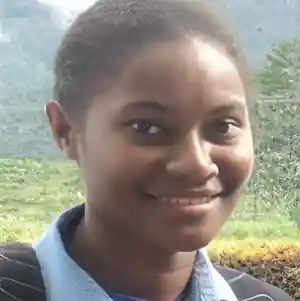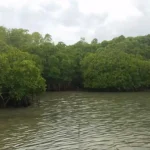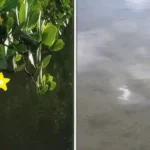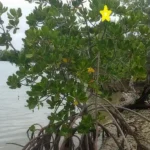Mangroves: The Forest Between Land and Sea
Table of Contents
Share This
What is a Mangrove?
Mangroves belong to a group of special species of plant life that grow in salty, wet soils and are adapted to survive during immersions at high tides. The term “mangrove” refers to all species of plants and shrubs that are adapted to living in salty, wet soil in the intertidal zone.
Mangroves have developed specialized plant structures that helps them survive in their difficult environment. A well-developed structure is the roots of mangrove trees. These specialized root structures help them to grow on soft soil by providing support for the tree. Different species of mangroves have different root adaptations, and this depends on where the mangrove grows.
For example, certain red mangroves species, such as Rhizophora spp., have prop roots that grow from the trunk and branches. This root system acts as a support for the plant. Black mangroves, such as Avicenna spp. grow in shallow areas, so they need shallow spreading roots. There are other species of mangroves that do not need specialized root structures because they grow on drier soils.
Where are mangroves found in the world?
There are about 50 species of mangroves found around the world. Mangroves grow typically in the tropical and subtropical coasts. These coastal areas are in places such as Africa, Australia and New Zealand, Japan, Florida, Bermuda and the Red Sea. Most mangrove forests occur in the Indo-Pacific and the Caribbean.
Guam also has some mangrove forests, but not many. Most of the mangrove areas on Guam are located on the southwest part of the island. The largest areas of mangroves occur along the eastern shores of Apra Harbor in Sasa Bay, with smaller stands present in Inalåhan and Malesso’, along the coast of the Achang Reef Flat. Guam has five Marine Preserves (MPs), which include Sasa Bay and Achang Reef Flat. These two MPs hold and protect the mangrove forests of the island. The Guam Department of Agriculture’s Division of Aquatic and Wildlife Resources (DAWR) is responsible for protecting MPs throughout the island.
Mangroves on Guam
The species of mangroves found on Guam are listed in Table 1. Of these species, the most dominant species of mangroves on include Rhizophora mucronata, Rhizophora apiculata, and Avicenna marina var. alba. Nipa palms are also very common along river banks and river mouths.
Table 1. Species of mangroves found on Guam
| Species | Common name | CHamoru name |
|---|---|---|
| Rhizophora mucronata | Red mangrove | Mangle hembra |
| Rhizophora apiculata | Red mangrove | No CHamoru name |
| Bruguiera gymnorrhiza | Large-leafed orange mangrove | Mangle macho |
| Avicenna marina var. alba | Grey mangrove | No CHamoru name |
| Lumnitzera littoral | Black mangrove | Ngånga’ |
| Nypa fruticans | Mangrove palm | Nipa |
| Xylocarpus moluccensis | Cannonball mangrove | Lalanyok |
| Heritiera littoralis | Native hibiscus tree | Ufa-Halomtano |
| Hibiscus tiliaceus | Native hibiscus tree | Pago |
| Acrostichum aurem | Golden-leather fern | Langayao |
Importance of mangroves
Mangroves are often regarded as ‘dump sites’, because these forests were often seen as useless wasted land. However, these forests play many important roles.
Ecological importance
Mangrove forests act as a link between land and sea, literally living in two worlds at once. Mangroves have much ecological importance, including protecting coastlines from erosion, storm damage, and wave action. They also act as buffers and catch sediment. This stabilizes and creates more land because sediment accumulates. When sediment accumulates in mangroves, they are protecting nearby coral reefs and seagrass beds. Without mangroves sediments can smother corals and seagrasses.
Mangrove forests help maintain healthy coastal ecosystems. The forest debris, consisting mainly of fallen leaves and branches, provides nutrients for the marine environment. It supports diverse communities of sea life in food webs that start with organisms that feed on this debris.
Prop roots create a habitat, shelter and breeding grounds for juvenile fish, crustaceans, molluscs, and other mangrove-associated organisms. Mangroves are also prime nesting and migratory sites for some shorebird species of Guam.
The importance of mangroves to human communities
Mangrove ecosystems have traditionally been sustainable managed by local populations to produce food, medicines, fuel wood, and construction materials. Many coastal communities depend on mangrove forests for their basic livelihoods and their traditional cultures. Traditionally in Guam, the lower coastal mangrove areas were used for taro patches and other agricultural activities.
Mangrove forests act as a buffer zone to protect property and losses of life from natural disasters such as typhoons and other storms. In places where mangroves have been cleared, there have been problems of erosion and siltation. Mangroves are also useful in treating sewer water. Mangrove areas contain important plants and bacteria that absorb excess nitrates and phosphates, which prevents these pollutants from entering nearby waters.
Mangroves are an important ecosystem that continue to play an significant role for the environment of Guam, and for the local communities that rely on them. Ecologists are trying to help protect the mangrove forests, by setting up MPs in areas where mangroves grow. This is helped through setting laws and regulations which includes monitoring of the MPs.
About the author

Mildred Kelokelo was a student in the University of Guam Masters of Biology Program in 2017, graduating in 2018. Her thesis was “Sexuality and Sex Change in the Arc-eye Hawkfish (Paracirrhites arcatus).”
Editor’s note: This author was a graduate student in 2017 taking a course in scientific writing at the University of Guam. This article was assigned to provide the student with practice in communicating science to non-scientists. The student chose the topic which is related either to their thesis project or work experience. The instructor in the course is Dr. Laurie Raymundo, a UOG Marine Laboratory faculty member.
For further reading
Fosberg, Francis R. “The Vegetation of Micronesia.” Bulletin of the American Museum of Natural History 119, no. 1 (1960): 1-75.
Moore, Philip, Lynn Raulerson, Mitchell Chernin, and Patrick McMakin. Inventory and Mapping of Wetland Vegetation in Guam, Tinian, and Saipan, Mariana Islands. Mangilao: Department of Biosciences, University of Guam, 1977.
Mueller-Dombois, Dieter, and Frederic R. Fosberg. Vegetation of the Tropical Pacific Islands. New York: Springer-Verlag, 1998.



